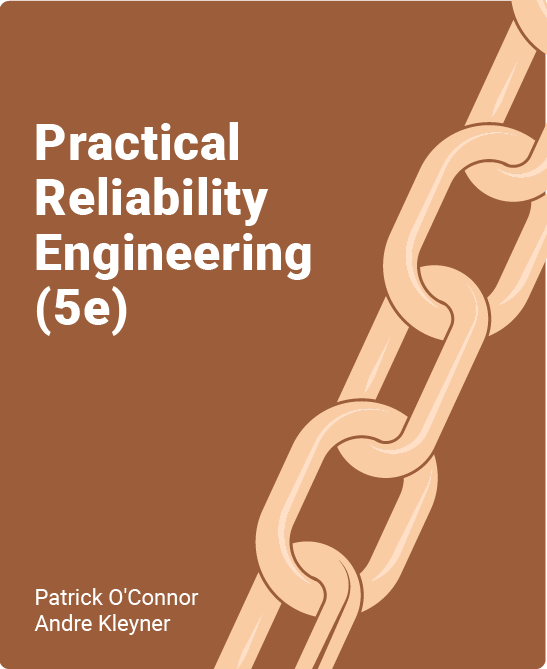Table of Contents
1 Introduction to Reliability Engineering
1.1 What is Reliability Engineering?
1.2 Why Teach Reliability Engineering?
1.3 Why Do Engineering Products Fail?
1.4 Probabilistic Reliability
1.5 Repairable and Non-Repairable Items
1.6 The Pattern of Failures with Time (Non-Repairable Items)
1.7 The Pattern of Failures with Time (Repairable Items)
1.8 The Development of Reliability Engineering
1.9 Courses, Conferences and Literature
1.10 Organizations Involved in Reliability Work
1.11 Reliability as an Effectiveness Parameter
1.12 Reliability Programme Activities
1.13 Reliability Economics and Management
2 Reliability Mathematics
2.1 Introduction
2.2 Variation
2.3 Probability Concepts
2.4 Rules of Probability
2.5 Continuous Variation
2.6 Continuous Distribution Functions
2.7 Summary of Continuous Statistical Distributions
2.8 Variation in Engineering
2.9 Conclusions
2.10 Discrete Variation
2.11 Statistical Confidence
2.12 Statistical Hypothesis Testing
2.13 Non-Parametric Inferential Methods
2.14 Goodness of Fit
2.15 Series of Events (Point Processes)
2.16 Computer Software for Statistics
2.17 Practical Conclusions
3 Life Data Analysis and Probability Plotting
3.1 Introduction
3.2 Life Data Classification
3.3 Ranking of Data
3.4 Weibull Distribution
3.5 Computerized Data Analysis and Probability Plotting
3.6 Confidence Bounds for Life Data Analysis
3.7 Choosing the Best Distribution and Assessing the Results
3.8 Conclusions
4 Monte Carlo Simulation
4.1 Introduction
4.2 Monte Carlo Simulation Basics
4.3 Additional Statistical Distributions
4.4 Sampling a Statistical Distribution
4.5 Basic Steps for Performing a Monte Carlo Simulation
4.6 Monte Carlo Method Summary
5 Load–Strength Interference
5.1 Introduction
5.2 Distributed Load and Strength
5.3 Analysis of Load–Strength Interference
5.4 Effect of Safety Margin and Loading Roughness on Reliability (Multiple Load Applications)
5.5 Practical Aspects
6 Reliability Prediction and Modelling
6.1 Introduction
6.2 Fundamental Limitations of Reliability Prediction
6.3 Standards Based Reliability Prediction
6.4 Other Methods for Reliability Predictions
6.5 Practical Aspects
6.6 Systems Reliability Models
6.7 Availability of Repairable Systems
6.8 Modular Design
6.9 Block Diagram Analysis
6.10 Fault Tree Analysis (FTA)
6.11 State-Space Analysis (Markov Analysis)
6.12 Petri Nets
6.13 Reliability Apportionment
6.14 Conclusions
7 Design for Reliability
7.1 Introduction
7.2 Design for Reliability Process
7.3 Identify
7.4 Design
7.5 Analyse
7.6 Verify
7.7 Validate
7.8 Control
7.9 Assessing the DfR Capability of an Organization
7.10 Summary
8 Reliability of Mechanical Components and Systems
8.1 Introduction
8.2 Mechanical Stress, Strength and Fracture
8.3 Fatigue
8.4 Creep
8.5 Wear
8.6 Corrosion
8.7 Vibration and Shock
8.8 Temperature Effects
8.9 Materials
8.10 Components
8.11 Processes
9 Electronic Systems Reliability
9.1 Introduction
9.2 Reliability of Electronic Components
9.3 Component Types and Failure Mechanisms
9.4 Summary of Device Failure Modes
9.5 Circuit and System Aspects
9.6 Reliability in Electronic System Design
9.7 Parameter Variation and Tolerances
9.8 Design for Production, Test and Maintenance
10 Software Reliability
10.1 Introduction
10.2 Software in Engineering Systems
10.3 Software Errors
10.4 Preventing Errors
10.5 Software Structure and Modularity
10.6 Programming Style
10.7 Fault Tolerance
10.8 Redundancy/Diversity
10.9 Languages
10.10 Data Reliability
10.11 Software Checking
10.12 Software Testing
10.13 Error Reporting
10.14 Software Reliability Prediction and Measurement
10.15 Hardware/Software Interfaces
10.16 Conclusions
11 Design of Experiments and Analysis of Variance
11.1 Introduction
11.2 Statistical Design of Experiments and Analysis of Variance
11.3 Randomizing the Data
11.4 Engineering Interpretation of Results
11.5 The Taguchi Method
11.6 Conclusions
12 Reliability Testing
12.1 Introduction
12.2 Planning Reliability Testing
12.3 Test Environments
12.4 Testing for Reliability and Durability: Accelerated Test
12.5 Test Planning
12.6 Failure Reporting, Analysis and Corrective Action Systems (FRACAS)
Chapter 11 Integration and Qualification
Chapter 12 A Complete Exercise of the Systems Engineering Process
13 Analysing Reliability Data
13.1 Introduction
13.2 Pareto Analysis
13.3 Accelerated Test Data Analysis
13.4 Acceleration Factor
13.5 Acceleration Models
13.6 Field-Test Relationship
13.7 Statistical Analysis of Accelerated Test Data
13.8 Reliability Analysis of Repairable Systems
13.9 CUSUM Charts
13.10 Exploratory Data Analysis and Proportional Hazards Modelling
13.11 Field and Warranty Data Analysis
14 Reliability Demonstration and Growth
14.1 Introduction
14.2 Reliability Metrics
14.3 Test to Success (Success Run Method)
14.4 Test to Failure Method
14.5 Extended Life Test
14.6 Continuous Testing
14.7 Degradation Analysis
14.8 Combining Results Using Bayesian Statistics
14.9 Non-Parametric Methods
14.10 Reliability Demonstration Software
14.11 Practical Aspects of Reliability Demonstration
14.12 Standard Methods for Repairable Equipment
14.13 Reliability Growth Monitoring
14.14 Making Reliability Grow
15 Reliability in Manufacture
15.1 Introduction
15.2 Control of Production Variability
15.3 Control of Human Variation
15.4 Acceptance Sampling
15.5 Improving the Process
15.6 Quality Control in Electronics Production
15.7 Stress Screening
15.8 Production Failure Reporting Analysis and Corrective Action System (FRACAS)
15.9 Conclusions
16 Maintainability, Maintenance and Availability
16.1 Introduction
16.2 Availability Measures
16.3 Maintenance Time Distributions
16.4 Preventive Maintenance Strategy
16.5 FMECA and FTA in Maintenance Planning
16.6 Maintenance Schedules
16.7 Technology Aspects
16.8 Calibration
16.9 Maintainability Prediction
16.10 Maintainability Demonstration
16.11 Design for Maintainability
16.12 Integrated Logistic Support
17 Reliability Management
17.1 Corporate Policy for Reliability
17.2 Integrated Reliability Programmes
17.3 Reliability and Costs
17.4 Safety and Product Liability
17.5 Standards for Reliability, Quality and Safety
17.6 Specifying Reliability
17.7 Contracting for Reliability Achievement
17.8 Managing Lower-Level Suppliers
17.9 The Reliability Manual
17.10 The Project Reliability Plan
17.11 Use of External Services
17.12 Customer Management of Reliability
17.13 Selecting and Training for Reliability
17.14 Organization for Reliability
17.15 Reliability Capability and Maturity of an Organization
17.16 Managing Production Quality
17.17 Quality Management Approaches
17.18 Choosing the Methods: Strategy and Tactics
17.19 Conclusions
zyText are leading print textbooks available in full on the zyBooks platform. Each zyText has been adapted to include learning questions and answer-specific feedback allowing for a quick and easy transition to an engaging digital experience for instructors and students.
What You’ll Find in this zyText
- Incorporates the complete text
- Over 150 learning questions with answer-specific feedback
- Customization tools letting you add, remove or reorder chapters and sections
- Options to align the book directly to your syllabus – including videos, images, text
- Analytics that help you measure student engagement
- Ability to hold students accountable for reading before class
- A competitive low price point
- Students can keep a PDF version of key chapters at no additional cost
With emphasis on practical aspects of engineering, this bestseller has gained worldwide recognition
through progressive editions as the essential reliability textbook.
Practical Reliability Engineering fulfils the requirements of the Certified Reliability Engineer
curriculum of the American Society for Quality (ASQ).
Includes:
- Applications of Monte Carlo simulation methods and reliability demonstration methods.
- Software applications of statistical methods, including probability plotting and a wider use of
common software tools. - Detailed descriptions of reliability prediction methods.
- Comprehensive treatment of accelerated test data analysis and warranty data analysis.
Authors
Patrick O’Connor and Andre Kleyner

